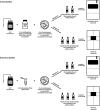Efficient Recovery of Candida auris and Five Other Medically Important Candida Species from Blood Cultures Containing Clinically Relevant Concentrations of Antifungal Agents
- PMID: 36715537
- PMCID: PMC10100679
- DOI: 10.1128/spectrum.04104-22
Efficient Recovery of Candida auris and Five Other Medically Important Candida Species from Blood Cultures Containing Clinically Relevant Concentrations of Antifungal Agents
Abstract
Candida auris and other Candida species (C. albicans, C. glabrata, C. parapsilosis, C. tropicalis, and C. krusei) are important causes of bloodstream infection. Early or prolonged treatment with antifungal agents is often required. The inhibitory effect of antifungal agents in the patients' bloodstream may compromise the sensitivity of blood culture (BC) to diagnose and/or monitor patients with candidemia. Using a clinical BC simulation model, we compared antimicrobial drug-neutralizing BC media in BacT/Alert FA PLUS (FAP) or Bactec Plus Aerobic/F (PAF) bottles with non-neutralizing BC media in Bactec Mycosis IC/F (MICF) bottles to allow Candida growth in the presence of 100%, 50%, or 25% peak serum level (PSL) antifungal concentrations. In total, 117 organism/antifungal combinations were studied, and Candida growth was detected after incubating bottles into BacT/Alert VIRTUO or Bactec FX BC systems. Compared to control (without antifungal) bottles, both FAP and PAF bottles with 100% PSL antifungal concentrations allowed 100% recovery for C. auris, C. glabrata, and C. parapsilosis, whereas recovery was below 100% for C. albicans, C. krusei, and C. tropicalis. MICF bottles were less efficient at 100%, 50%, or 25% PSL antifungal concentrations, for all Candida species, except for C. auris. While azoles and amphotericin B did not hinder Candida growth in FAP or PAF bottles, echinocandins allowed C. auris, C. glabrata, and C. parapsilosis to grow in FAP, PAF, or MICF bottles. Overall, the maximum time to detection was 4.6 days. Taken together, our findings emphasize the reliability of BCs in patients undergoing antifungal treatment for candidemia. IMPORTANCE While echinocandins remain the preferred antifungal therapy for candidemia, bloodstream infections caused by C. auris, C. glabrata, or, at a lesser extent, C. parapsilosis may be difficult to treat with these antifungal agents. This is in view of the high propensity of the above-mentioned species to develop antifungal resistance or tolerance during treatment. Azoles and amphotericin B are possible alternatives. Thus, optimizing the recovery of Candida from BCs is important to exclude the likelihood of negative BCs for Candida species, owing to the inhibitory effect of antifungal agents present in the blood sample with which BCs are inoculated. Consistently, our results about the recovery of medically important Candida species (including C. auris) from simulated BCs in BacT/Alert FAP, Bactec PAF, or Bactec MICF bottles containing clinically relevant antifungal concentrations add support to this research topic, as well as to the use of BCs for monitoring the clinical and therapeutic course of candidemia.
Keywords: BacT/Alert bottles; Bactec bottles; Candida species; antifungal agents; blood cultures; candidemia.
Conflict of interest statement
The authors declare no conflict of interest.
Figures



References
LinkOut - more resources
Full Text Sources
Miscellaneous

